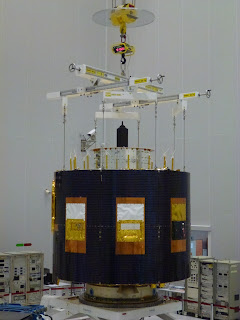Before fuelling MSG-3, the exact dry mass of the satellite needs to be determined. This dry mass, summed up with the mass of propellant plus/minus the few red and green tag items to be added and removed for launch, will provide the exact mass the spacecraft at launch.
The dry mass is calculated with a method called in French the "double pesée" (double weighing). This enables to eliminate the inaccuracy of the weighing method.
The principle is simple:
You use a calibrated load cell, you make two measurements of the device you want to determine the exact mass and you repeat the same measurement with calibrated load masses. The sum of all the calibrated masses to reach the exact weight of the specimen as read on the load cell gives you the exact mass. There are also some mathematics formulas to apply to get the final value and increase accuracy and precision.
First, the lifting device is weighed,
then MSG-3 is weighed and the masses read on the load cell are respectively recorded.As the load cell is digital, it is need to add small masses to "pass" the digit for accuracy purposes.
The little pot, you see above is not to get the last drop of oil during servicing or to collect money for the coffee club, it is just the right place to put the small masses to "pass" the digit and get an accurate value on the load cell. As it can be seen on the picture below, the mass read after the addition of these small loads has "passed" the digit to exactly indicate 2104,0 kgs.
The last part of the measurement consists to weigh calibrated masses as showed below. As explained above, the sum up of all these calibrated loads plus a bit of mathematics will provide the exact value.
This second weighing is made first for the lifting device (to obtain Mp) and then for the Spacecraft plus the lifting device (to obtain Me). Each of these measurements is repeated twice.
The dry mass of the MSG-3 spacecraft calculated today is : Me-Mp=1064,6 kgs.
For memory the value obtained for MSG-2 almost 7 years ago, calculated with the same method was 1068,0 kgs, showing a difference of less than 0,4%.
As expected MSG-2 and MSG-3 are really twins :-)





No comments:
Post a Comment
Note: Only a member of this blog may post a comment.